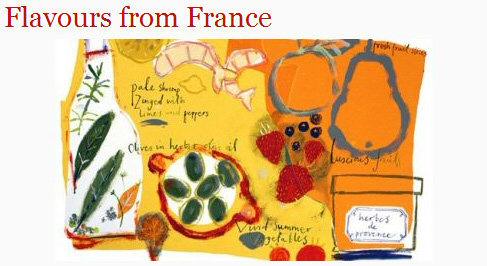June 2008

Buenos Aires offers up a wide variety of places where you can enjoy a French meal filled with the spirit of the wonderful haute cuisine.
There was a time when going out to dine pretty much meant going out for French food. It seemed to be ubiquitous in the Americas and throughout Europe that French food was automatically equated with fine, no, make that the finest dining. And, there’s no doubt that it’s true that the fancy end of French cooking is amongst the best of cuisines in the world – not the only, but one of. It should be remembered, as well, that French cuisine also tends to shine at the low end – rustic, simple, bistro or brasserie cooking is heartwarming and delicious.
Here in Buenos Aires there are not a huge number of places to eat in the Gallic tradition. There are certainly some high end places – most of them in hotels, and they are fine places to go, but tend in the direction that fancy French hotel dining rooms do – a bit stuffy. Better yet, hit one of the few independent French spots for white tablecloth fare – Les Anciens Combattants, Maat, maybe Nectarine, or, my personal favorite, Lola, at the corner of Junín and Guido, in Recoleta. There, you can start your evening with a classic steak tartare, prepared tableside to your own personal tastes, and move on to a variety of beautifully presented classic dishes – duck a l’orange, salmon with duxelles encased in pastry, or stuffed, roasted quail – all of which have been updated to fit modern sensibilities.
Another great choice is Rabelais, a fancied up bistro in the heart of the wealthy old section of Recoleta, at Libertad 1319, where you can feast on perfectly prepared coq au vin, boeuf bourguignonne, one of the best classic onion soups you’ll ever have outside of France, and a dead-on tarte tatin.
In the mid-range are the brasseries and bistros – the best known is probably Bar Petanque in San Telmo. Its sister restaurant Bouchon Bistro, at Tucumán 400, in the Microcentro far outshines it with friendly, helpful service and decent Lyonnaise style cooking. Nearby at Tucumán 775, you can find Brasserie Berry, as classic as they come with simple dishes of steak or roasted chicken served with a side of potato or salad, a glass of wine, and perhaps a chocolate mousse or Crepes Suzette for dessert.
For my tastes in the middle price range and style, there are two Recoleta spots that garner honors for best of show – Granda Bistro, along Junín, at 1281. A small, cozy spot, with a regularly changing menu, a great wine selection, and friendly, helpful service. They serve up wonderful country style pate, delicious hearty rabbit and lamb dishes, and wonderful traditional desserts like creme brulee and apple strudel. The other is La Olla de Félix, at Juncal 1693, with its menu of only four or five items that changes daily – especially their filled crepes. No appetizers other than, perhaps, a salad or soup, and perfect, but simple, desserts.
Speaking of crepes, at the simplest end is an unusual entry, a small, cafe-like spot called Finistere, at Montevideo 973, in the Centro area, that offers up the traditional buckwheat crepes of Brittany. Some have been updated for local tastes, but their best are filled with classic combinations, like morcilla (blood sausage) and apple, or another filled with wild mushrooms and vegetables. Desserts are typical of the Breton region, and worth trying. The wine selection is limited but goes with the food, and the prices are easy on the wallet.
In the French vein, it’s hard to find wines of France here. There are certainly the overpriced top end Bordeaux and Burgundies offered up by some of the big hotel chains or fancier restaurants, and a few of the better wine shops, like Terroir in Palermo or Grand Cru in Recoleta, stock a limited selection of the same. But keep in mind that many of the grapes grown here in Argentina are French imports, be they Cabernet Sauvignon, Merlot, Chardonnay, or Sauvignon Blanc, or the more popular, Malbec. Less well known would be the grape Tannat, which comes from the southwest of France in a region called Madirán, where it produces dense, tannic wines that often require a half dozen years or more of aging just to be smooth enough to consider drinking. While not Argentina’s star production, there are a couple of producers who have brought out excellent local versions. In particular, one producer stands out in my mind, Bodegas Quara, who produce both a light, simple, easy drinking basic Tannat, and also a earthy, medium tannic, hearty, oaked Tannat Reserva. Another good option would be the Bodegas Callia Magna Tannat, a rich, aromatic, and hearty bottle that goes great with red meat.
Rabelais, Libertad 1319 – Recoleta.
Bouchon Bistro, Tucumán 400 – Microcentro.
Brasserie Berry, Tucumán 775 – Microcentro.
Granda Bistro, Junín 1281 – Recoleta.
La Olla de Félix, Juncal 1693 – Recoleta.
Finistere, Montevideo 973 – Barrio Norte.
Les Anciens Combattants, Santiago del Estero 1435 – San Telmo.
Maat club privado gourmet, Sucre 2168 – Belgrano.
Nectarine, Vicente López 1661 – Recoleta.
Bar Petanque, Defensa 595 – San Telmo.
Lola, Roberto M. Ortiz y Guido – Recoleta.
In October 2006, I started writing for this Spanish language magazine, covering their English language section for travellers. I wrote for them for about two years. The copy editor, apparently not fluent in English, used to put each paragraph in its own text box on a two column page, in what often seemed to be random order, making the thread of the column difficult to follow. I’ve restored the paragraphs to their original order.